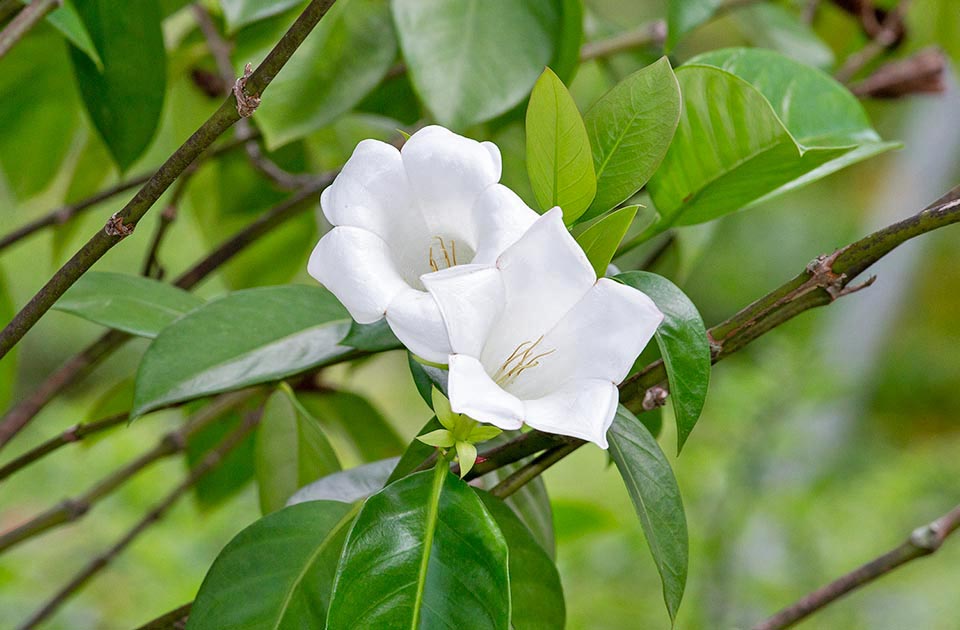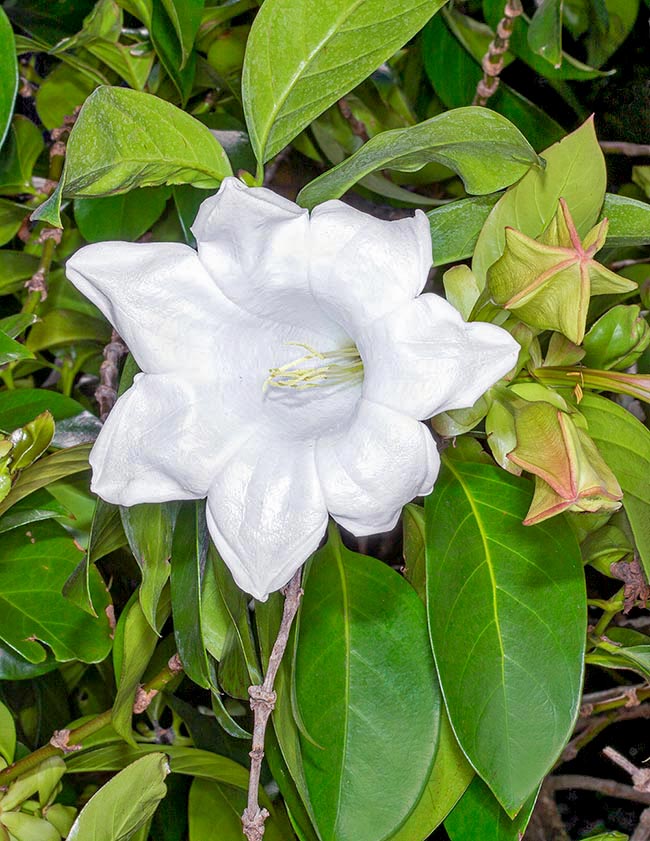Family : Rubiaceae

Text © Pietro Puccio

English translation by Mario Beltramini
The species is native to Jamaica where it grows in the thickets and forests on rocky and calcareous slopes at low altitudes.
The genus was dedicated by the Irish bot;anist and physician Patrick Browne (1720-1790) to the Duchess of Portland, Margaret Cavendish Bentinck (1715-1785), lover of botany, collector and profoud connoisseur of the English flora; the specific name is the combination of the Latin adjective “grandis, e” = big and of the substantive “flos, -oris” = flower, with obvious reference.
Common names: bell flower, glorious flower of Cuba, Jamaican bell flower, Jamaican tree-lily, portlandia, tree lily (English); campana grande (Spanish).

Native to Jamaica, Portlandia grandiflora is a shrub or a small evergreen tree, particularly slow in its growth, 2-6 m tall © Giuseppe Mazza
Portlandia grandiflora L. (1759) is an evergreen shrub or small tree with a particularly slow growth, 2-6 m tall, with an erect trunk having a longitudinally fissured bark.
The leaves, subsessile or on short petiole, are simple, opposite, ovate-elliptic with acute apex and entire margin, 10-16 cm long and 6-8 cm broad, of glossy dark green colour above, paler below, thick and coriaceous.

Unusual 5 lobes ovate calyxes with sharp apex and candid flowers, 10-16 cm long and 5-6 cm broad. They attract the pollinators, especially the night, with an intense vanilla to chocolate scent © Giuseppe Mazza
Hermaphrodite flowers on a 1-1,4 cm long peduncle, usually solitary at the axil of the upper leaves, 10-16 cm long and of 5-6 cm of diameter, of white or cream white colour, that emit a fragrance, between vanilla and chocolate, stronger during the night.
5 ovate lobes calyx with acuminate apex, about 2 cm long, corolla with pentagonal tube having 5 almost triangular lobes, about 2 cm long, and 5 stamens of the same length as that of the tube.
The fruits are woody ovoid capsules, about 2,5 cm long and of 1,5 cm of diameter, containing numerous small seeds.
It reproduces by seed, previously kept in water for 24 hours, in light loam, draining, maintained humid, but without stagnations, at the temperature of 24-28 °C, with germination times between 1 and 3 months, it may propagate, with a certain difficult, also by air layering and apical cutting.
Species having an ornamental foliage and a dramatic flowering almost continuous from spring to autumn, cultivable in the tropical and subtropical climate, constantly humid and rainy as well as with a marked dry season; it does not stand temperatures close to 0 °C if not exceptional and for a very short period.
It requires full sun, where it assumes a more compact posture, or light shade in the afternoon hours, and perfectly draining soils, rich, preferably calcareous; does not bear the salty winds and a particular attention is to be done in the repottings for the delicate root system.
During the first years of planting requires regular waterings during the dry periods; useful are the fertilizations with slow release balanced products. It grows well also in pots, where it may remain for a long time due to its slow growth, for the decoration of open spaces even in the zones not favoured by the climate, sheltering it in the coldest months in a bright environment with temperatures never under 15 °C.
Synonyms: Portlandia grandiflora var. parviflora S.Moore (1930).
→ To appreciate the biodiversity within the RUBIACEAE family please click here.
